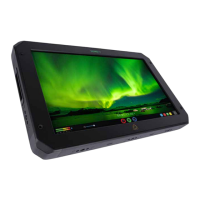*Subject to change without notice Atomos Sumo19 – User Manual Edition 1: September 2017 6
What you also need
Widelyavailable2.5”drivesarethebasicstoragemediumfor4KMonitor
recorder. We work closely with all the leading drive manufacturers to
qualify as many options as possible. Hard drives / HDD or Spinning disk
can only be used for HD recording. Solid State Drives / SSD are required
for4Krecordingorformoredemandingproductionenvironmentsthatmay
not be suited to HDDs.
See the section below about when you should consider using SSDs.
Which drives should you use?
There are so many drives available, and newer models appear all the
time. We are not able to test all drives but here are some guidelines.
Spinning Disk Drives (HDD) are recommended for recording up to
1080p30/1080i60 HD video only
Solid State Drives (SSDs) are recommended for recording up to
4KUHDp30and4KDCIp30fromRAW
Speed and reliability are the main factors. Here are a few things to
bear in mind:
• Disk drive data rates tend to be given in megabytes per second,
and codec data rates are normally given in megabits per second.
It’s very easy to get confused. But there’s no need to be, because all
you have to do to convert megabits to megabytes is divide by 8. So if
you’re recording at 220 megabits per second, that’s going to result in
220/8 megabytes per second, which is 27.5 megabytes per second.
• We recommend at least 7200 RPM drives. Just remember that the
higher the bit-rate of the codec you’re using, the faster the drive
needstobe,with4Krecordingyourdatarateisfourtimesfromthat
of HD recording, please ensure your drive is capable of keeping up
with4Kwritespeedrequirements.
Atomos regularly test hard drives – please check this link before
purchasing drives: http://www.atomos.com/drives
MechanicalShockandVibrationforSpinningDiskHDD’s
Hard disks are precision mechanical devices that need to be handled
carefully. The use of mechanical drives or Solid State drives will vary
dependingontheintendedlmingapplication.
We can’t give rigid guidelines because there are so many different kinds
ofdrives,eachwhichhasdifferentmechanicalproperties.Youmaynd
variations between drives of the same type.
What we have found is that mechanical drives are suitable for most
purposes that don’t involve harsh vibration or mechanical shocks. We
would not advise using mechanical disks if there is a likelihood that they
might be dropped onto a hard surface.
Here are some things that you should bear in mind when using
spinning disks:
• Even though spinning drives can withstand substantial shocks
when they are not in use, they are more vulnerable when running.
Harsh treatment that may not actually damage the drive may interrupt
recordings at a much lower level of severity. We recommend that you
experiment with your drives by testing them in the conditions that you
normally work in.
• Do not bang or jolt the Sumo19 while recording.
•Donotusespinningdrives(HDD)forrecording4Kvideo
• Youwillndnoticeabledifferencesintheabilityofdrivestowithstand
shock and to continue recording during vibration and movement.

